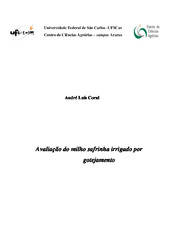| dc.contributor.author | Coral, André Luís | |
| dc.date.accessioned | 2021-07-21T16:48:32Z | eng |
| dc.date.available | 2021-07-21T16:48:32Z | eng |
| dc.date.issued | 2021-06-26 | eng |
| dc.identifier.citation | CORAL, André. Avaliação do milho safrinha irrigado por gotejamento. 2021. Trabalho de Conclusão de Curso (Graduação em Engenharia Agronômica) – Universidade Federal de São Carlos, São Carlos, 2021. Disponível em: https://repositorio.ufscar.br/handle/ufscar/14645. | * |
| dc.identifier.uri | https://repositorio.ufscar.br/handle/ufscar/14645 | por |
| dc.description.abstract | Corn (Zea Mays L.) is one of the most economically exploited crops in the world, Brazil being the third largest producer and second largest exporter in the world. Its cultivation as a off-season in the country has become increasingly common in all regions, however, one of the limiting factors for its planting is the occurrence of dry period in summer, harming its productivity. Therefore, the irrigation systems use has become advantageous, since the corn crop to develop properly needs a large amount of water in different plant stages. The objective of this work was to evaluate the development and productivity of off-season corn irrigated by drip system irrigation and non-irrigated. The work has been carried out at Ufscar- Araras, in area of 40 x 35m, with 34 planting lines, being 17 irrigated and 17 non-irrigated. The water application has been made by self-compensating driplines, model Top Drip, flow of 1 Liter per hour, spacing of 0.30m and operating pressure of 1.4 bar. The soil moisture measurement, has been accomplished by tensiometers installed at two depts. Plant height, stem diameter and third leaf length were evaluated, as well as the diameter of the ears of corn, weight, length, 1000 grain weight, number of grains per ear and grain yield. The irrigated plants have been shown a greater vegetative development, quality and grain yield than the non-irrigated plants. | por |
| dc.description.sponsorship | Não recebi financiamento | por |
| dc.language.iso | por | por |
| dc.publisher | Universidade Federal de São Carlos | por |
| dc.rights | Attribution-NonCommercial-NoDerivs 3.0 Brazil | * |
| dc.rights.uri | http://creativecommons.org/licenses/by-nc-nd/3.0/br/ | * |
| dc.subject | Biometria | por |
| dc.subject | Sistema de irrigação localizada | por |
| dc.subject | Produtividade | por |
| dc.title | Avaliação do milho safrinha irrigado por gotejamento | por |
| dc.title.alternative | Evaluation of off-season corn irrigated by drip system irrigation | eng |
| dc.type | TCC | por |
| dc.contributor.advisor1 | Bizari, Douglas Roberto | |
| dc.contributor.advisor1Lattes | http://lattes.cnpq.br/0558728017553792 | por |
| dc.description.resumo | O milho (Zea Mays L.) é uma das culturas mais exploradas economicamente no mundo, sendo o Brasil o terceiro maior produtor e o segundo maior exportador mundial. O seu cultivo como safrinha, no país, vem se tornando cada vez mais comum em todas as regiões, porém, um dos fatores limitantes do seu plantio é a ocorrência de veranicos, prejudicando a sua produtividade. Assim, a utilização de sistemas de irrigação vem se tornando vantajosa, uma vez que a cultura do milho para se desenvolver adequadamente, necessita de grande quantidade de água em diferentes estágios da planta. O objetivo do trabalho foi avaliar o desenvolvimento e a produtividade do milho safrinha em sistema irrigado por gotejamento e na condição de sequeiro. O experimento foi realizado na UFSCar- Araras, em uma área de 40 x 35m, com 34 linhas de plantio, sendo 17 irrigadas e 17 não irrigadas A aplicação da água foi feita por tubos gotejadores autocompensantes modelo TOPDRIP de polietileno com vazão de 1.0 Litro/hora, espaçamento de 0,30m e pressão de serviço de 1.4 bar. Para o monitoramento da umidade do solo foram instaladas duas baterias de tensiômetros (20 e 40 cm de profundidade). Foram realizadas avaliações da altura da planta, diâmetro do caule e comprimento da terceira folha e também o diâmetro da espiga, peso, comprimento, peso de 1000 grãos, número de grãos por espiga e produtividade de grãos. As plantas irrigadas apresentaram um maior desenvolvimento vegetativo e maior qualidade e produtividade de grãos que as plantas cultivadas em sequeiro. | por |
| dc.publisher.initials | UFSCar | por |
| dc.subject.cnpq | CIENCIAS AGRARIAS::ENGENHARIA AGRICOLA | por |
| dc.publisher.address | Câmpus Araras | por |
| dc.contributor.authorlattes | http://lattes.cnpq.br/1570411360322144 | por |
| dc.publisher.course | Engenharia Agronômica - EAg-Ar | por |

